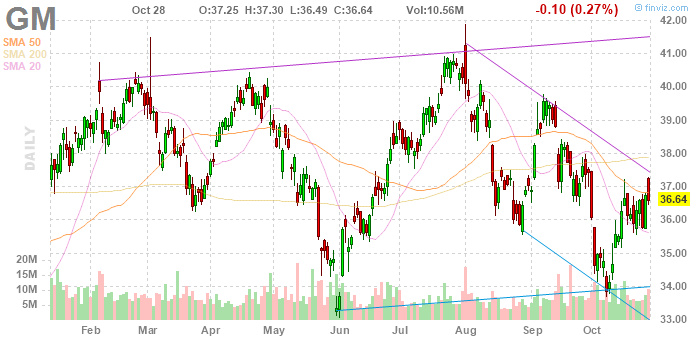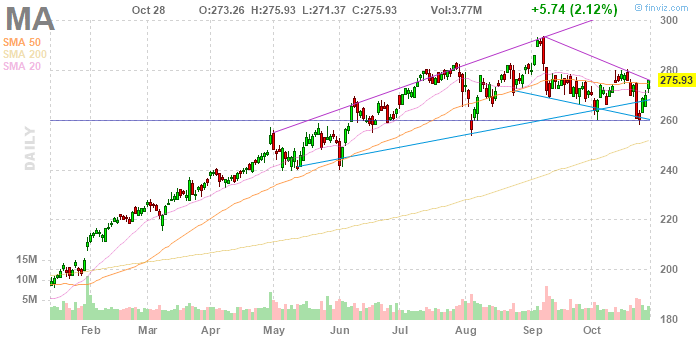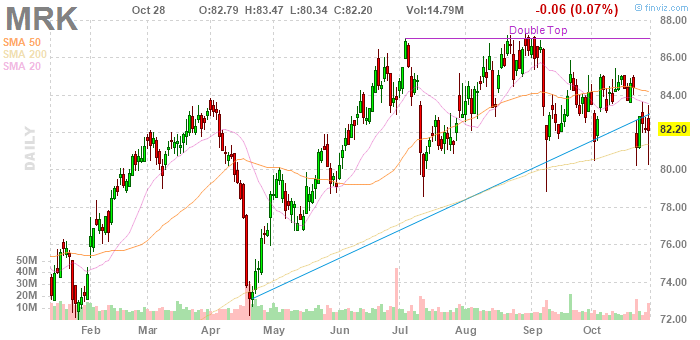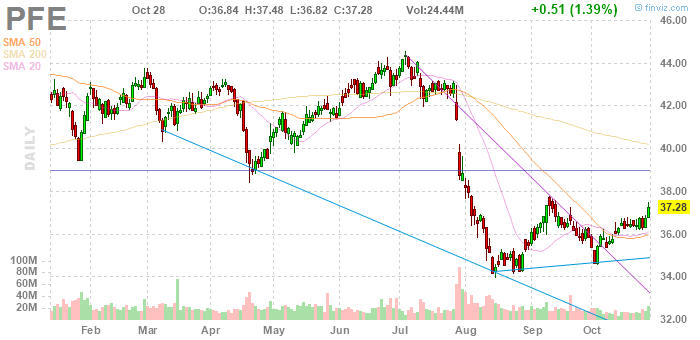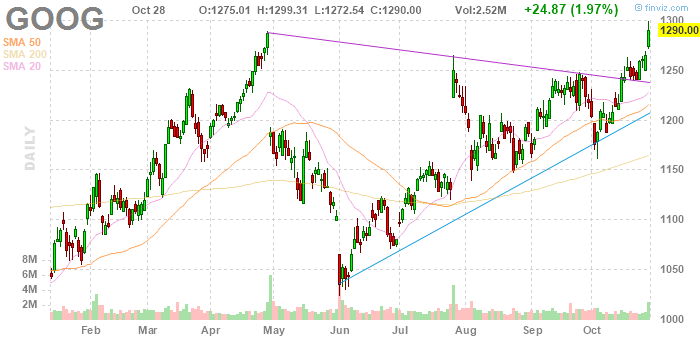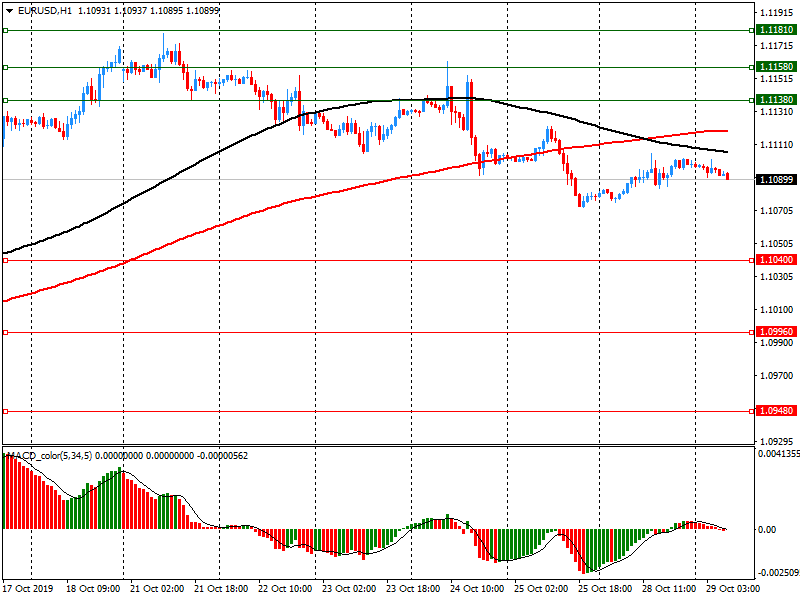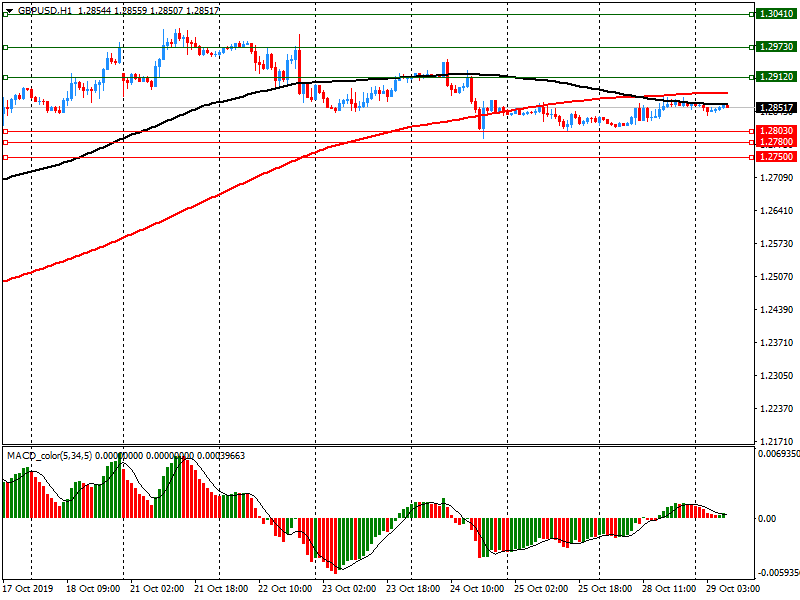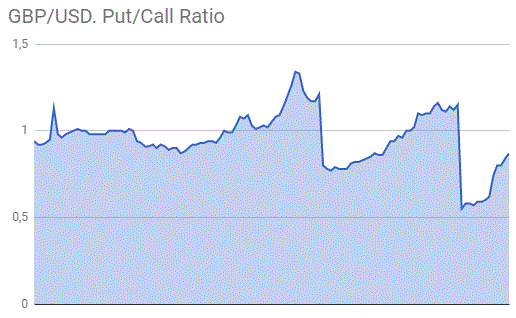- Analiza
- Novosti i instrumenti
- Vesti sa tržišta
Forex-novosti i prognoze od 29-10-2019
| Time | Country | Event | Period | Previous value | Forecast |
|---|---|---|---|---|---|
| 00:30 | Australia | Trimmed Mean CPI y/y | Quarter III | 1.6% | 1.6% |
| 00:30 | Australia | Trimmed Mean CPI q/q | Quarter III | 0.4% | 0.4% |
| 00:30 | Australia | CPI, q/q | Quarter III | 0.6% | 0.5% |
| 00:30 | Australia | CPI, y/y | Quarter III | 1.6% | 1.7% |
| 06:30 | France | GDP, q/q | Quarter III | 0.3% | 0.2% |
| 07:45 | France | Consumer spending | September | 0% | 0.1% |
| 08:00 | Switzerland | KOF Leading Indicator | October | 93.2 | 93.9 |
| 08:55 | Germany | Unemployment Change | October | -10 | 2 |
| 08:55 | Germany | Unemployment Rate s.a. | October | 5% | 5% |
| 09:00 | Switzerland | Credit Suisse ZEW Survey (Expectations) | October | -15.4 | -6.8 |
| 10:00 | Eurozone | Consumer Confidence | October | -6.5 | -7.6 |
| 10:00 | Eurozone | Industrial confidence | October | -8.8 | -8.9 |
| 10:00 | Eurozone | Economic sentiment index | October | 101.7 | 101.1 |
| 10:00 | Eurozone | Business climate indicator | October | -0.22 | -0.24 |
| 12:15 | U.S. | ADP Employment Report | October | 135 | 132 |
| 12:30 | U.S. | PCE price index, q/q | Quarter III | 2.4% | 2% |
| 12:30 | U.S. | GDP, q/q | Quarter III | 2% | 1.7% |
| 13:00 | Germany | CPI, m/m | October | 0% | 0% |
| 13:00 | Germany | CPI, y/y | October | 1.2% | 1.1% |
| 14:00 | Canada | Bank of Canada Monetary Policy Report | |||
| 14:00 | Canada | Bank of Canada Rate | 1.75% | 1.75% | |
| 14:30 | U.S. | Crude Oil Inventories | October | -1.699 | |
| 15:15 | Canada | BOC Press Conference | |||
| 17:30 | Eurozone | ECB's Lautenschläger Speech | |||
| 18:00 | U.S. | FOMC Statement | |||
| 18:00 | U.S. | Fed Interest Rate Decision | 2% | 1.75% | |
| 18:30 | U.S. | FOMC Press Conference | |||
| 21:45 | New Zealand | Building Permits, m/m | September | 0.8% | 2.3% |
| 23:50 | Japan | Industrial Production (MoM) | September | -1.2% | 0.4% |
| 23:50 | Japan | Industrial Production (YoY) | September | -4.7% | -4.1% |
The main US stock indices fell slightly, as investors assessed mixed quarterly results of US companies and conflicting reports on the prospects of a trade deal between the US and China.
The Chinese publication South China Morning Post (SCMP) announced in the morning that Chinese President Xi Jinping and US President Donald Trump will meet on the sidelines of the Asia-Pacific Economic Cooperation (APEC) summit in Santiago (Chile) on November 17 to sign an interim trade agreement, “If everything goes smoothly.” This publication was informed by an informed source. However, later Reuters reported that the signing of the phase-1 trade agreement may not take place at the summit in Chile. As a source in the administration told the agency, the fact that the deal will not be signed simply means that it takes more time to move forward.
Market participants also focused on Conference Board data, which showed that consumer confidence in the United States unexpectedly fell in October amid household fears about short-term business prospects and employment prospects. According to the Conference Board report, the consumer confidence index fell to 125.9 this month from an upwardly revised 126.3 in September. It was previously reported that the index was 125.1 in September. Economists had forecast an increase to 128.0 in October.
It also became known that contracts for the purchase of previously owned houses grew more than expected in September, suggesting that the housing market is gaining momentum due to lower mortgage rates, although limited supply remains a limiting factor. According to the National Association of Realtors, the pending home sales index, based on contracts signed last month, rose 1.5% to 108.7. Economists predicted that in September the index would increase by 0.9%. In annual terms, pending home sales increased 3.9% in September.
Investors also expect the announcement of the results of the October meeting of the Fed. The central bank is expected to cut interest rates by 25 basis points tomorrow. This will be the third Fed rate cut this year.
Most of the DOW components completed trading in the red (19 of 30). Outsiders were Apple Inc. (AAPL; -2.12%). The biggest gainers were Merck & Co. (MRK; + 3.36%).
S&P sectors showed mixed dynamics. The health sector grew the most (+ 0.8%). The largest decline was shown by the technology sector (-0.8%).
At the time of closing:
Dow 27,070.60 -20.12 -0.07%
S&P 500 3,036.87 -2.55 -0.08%
Nasdaq 100 8,276.85 -49.13 -0.59%
| Time | Country | Event | Period | Previous value | Forecast |
|---|---|---|---|---|---|
| 00:30 | Australia | Trimmed Mean CPI y/y | Quarter III | 1.6% | 1.6% |
| 00:30 | Australia | Trimmed Mean CPI q/q | Quarter III | 0.4% | 0.4% |
| 00:30 | Australia | CPI, q/q | Quarter III | 0.6% | 0.5% |
| 00:30 | Australia | CPI, y/y | Quarter III | 1.6% | 1.7% |
| 06:30 | France | GDP, q/q | Quarter III | 0.3% | 0.2% |
| 07:45 | France | Consumer spending | September | 0% | 0.1% |
| 08:00 | Switzerland | KOF Leading Indicator | October | 93.2 | 93.9 |
| 08:55 | Germany | Unemployment Change | October | -10 | 2 |
| 08:55 | Germany | Unemployment Rate s.a. | October | 5% | 5% |
| 09:00 | Switzerland | Credit Suisse ZEW Survey (Expectations) | October | -15.4 | -6.8 |
| 10:00 | Eurozone | Consumer Confidence | October | -6.5 | -7.6 |
| 10:00 | Eurozone | Industrial confidence | October | -8.8 | -8.9 |
| 10:00 | Eurozone | Economic sentiment index | October | 101.7 | 101.1 |
| 10:00 | Eurozone | Business climate indicator | October | -0.22 | -0.24 |
| 12:15 | U.S. | ADP Employment Report | October | 135 | 132 |
| 12:30 | U.S. | PCE price index, q/q | Quarter III | 2.4% | 2% |
| 12:30 | U.S. | GDP, q/q | Quarter III | 2% | 1.7% |
| 13:00 | Germany | CPI, m/m | October | 0% | 0% |
| 13:00 | Germany | CPI, y/y | October | 1.2% | 1.1% |
| 14:00 | Canada | Bank of Canada Monetary Policy Report | |||
| 14:00 | Canada | Bank of Canada Rate | 1.75% | 1.75% | |
| 14:30 | U.S. | Crude Oil Inventories | October | -1.699 | |
| 15:15 | Canada | BOC Press Conference | |||
| 17:30 | Eurozone | ECB's Lautenschläger Speech | |||
| 18:00 | U.S. | FOMC Statement | |||
| 18:00 | U.S. | Fed Interest Rate Decision | 2% | 1.75% | |
| 18:30 | U.S. | FOMC Press Conference | |||
| 21:45 | New Zealand | Building Permits, m/m | September | 0.8% | 2.3% |
| 23:50 | Japan | Industrial Production (MoM) | September | -1.2% | 0.4% |
| 23:50 | Japan | Industrial Production (YoY) | September | -4.7% | -4.1% |
Economists at ING are not expecting the Bank of Canada (BoC) to follow the Fed with rate cuts just yet.
- "The latest jobs report showed employment creation was essentially in the public sector with private-sector jobs falling 21,000. The Ivey Purchasing Managers’ Index fell into contraction territory while retail sales surprisingly fell 0.1%MoM in August versus expectations of a decent 0.4% gain.
- Moreover, the global growth story is looking less positive with evidence spreading of a deceleration in US growth at a time when Europe’s economy is stagnant and Asia's is softening. Canada is heavily exposed to these external threats given the Canadian economy is relatively open with trade accounting for more than 30% of economic activity versus little more than 10% for the US. Canada is also more dependent on commodities with mineral extraction and agriculture, representing more than 10% of the economy.
- As such, we think the likelihood of a Canadian interest rate cut is greater than that implied by market pricing. After all, the BoC has a tendency to move swiftly after signalling a shift in thinking. Remeber back in 2015 when the BoC rapidly changed its tune and cut rates in response to plunging oil prices and the fears for what it might mean for the broader economy? Recall, too, 2017, when it surprised with a September hike after already increasing rates in July. Swift, but modest action seems to be the BoC's mantra. We continue to see a decent chance of a surprise December BoC rate cut."
Analysts at Rabobank suggest that a steady policy from the BoJ this week could lead to a modest move lower in the value of USD/JPY.
- "Due to the impact of a flat yield curve on the profitability of commercial banks, the BoJ operates its huge QQE policy with a ‘yield curve control’ component.
- Although Japanese banks have reportedly ramped up their exposure to good quality US credit, there is still the increased risk that Japan will directly import any stresses suffered in the US economy going forward.
- Given speculation of a possible recession in the US next year, this presents another reason for the BoJ to leave a rate cut on the table."
Andreas Steno Larsen, an analyst at Nordea Markets, suggests that the trend towards lower USD hedge costs remains intact.
- “The Fed has more room to cut than the ECB, which leaves the lower hedge costs story fully alive. The xCcy basis has also “cheapened” from a hedging perspective, but that trend could reverse.
- We have called for cheaper USD hedge costs (hedging of USD income and USD assets) for some quarters in a row now and we remain comfortable with the direction of that call. The simple reason is that the Fed has more room to cut rates than the ECB and other comparable central banks.
- We, therefore, reiterate that rolls of existing USD asset hedges should be kept short on the curve (<3-4 months) to take advantage of the narrowing potential of USD-EUR spreads. Otherwise, it makes sense to add to USD hedges via the xCcy basis as it is the component of the USD hedge costs that could become more expensive seen from a European perspective. Markets currently agree with this narrative, with more cuts priced in from the Fed than the ECB. However, in our view the risk/reward relationship is in favour of further narrowing of the USD-EUR spread than priced in by the markets.”
Andreas Steno Larsen, an analyst at Nordea Markets, suggests that they continue to see the best risk/reward in betting on more Fed rate cuts than priced in by the markets because of the strong USD and tight USD liquidity.
- “Tighter USD liquidity and a stronger USD spot level often precedes a global slowdown, and this has also been the case throughout 2019. The reason is that the world relies on cheap USD (in particular the Emerging Markets do).
- Another way to showcase the firm Fed policy is via the percentage of western central banks with a policy rate below that of the Fed. Until very recently that stood at 100% of developed market central banks, but the CNB has now taken the front seat on policy rates.
- It is no wonder that the USD stands firm with almost no other major central banks having a higher policy rate. A weaker USD and an easier Fed policy are probably prerequisites for a turnaround of the current global slowdown and the Fed will probably have to narrow the policy spread versus most of its peers to manufacture that.
- Even though it may be too early to rule out attempts by Christine Lagarde to take the ECB deposit rate deeper into negative territory, markets may very well continue to factor in much bigger easing prospects for the Fed than the ECB in their futures pricing. This should continue to underpin the narrative of lower USD hedge costs.”
Prashant Newnaha, the senior Asia-Pacific rates strategist at TD Securities, notes that the RBA Governor delivered a speech in Canberra today titled "Some Echoes of Melville" and it focused on appropriate RBA objectives and a discussion of the current low global interest rate environment.
- “There was nothing in today's speech to indicate the Bank is looking to cut the cash rate imminently and the Governor made no mention of 'spare capacity' or of 'unconventional' monetary policy. That said the Governor indicated the Board is willing to cut rates further if needed but deemed negative rates as 'extraordinarily unlikely' in Australia.
- Today's speech clearly outlined the environment in which the Bank is setting interest rates. With the Governor recognizing "monetary policy is not working in exactly the same way it used to", one could interpret today's speech as initiating the discussion around policy options and trade-offs that ultimately see the Bank resorting to 'unconventional' policy next year.”
The National
Association of Realtors (NAR) announced on Tuesday its seasonally adjusted
pending home sales index (PHSI) rose 1.5 percent m-o-m to 108.7 in September,
after a revised 1.4 percent m-o-m gain in August (originally an advance of 1.6 percent
m-o-m).
Economists had
expected pending home sales to increase 0.9 percent m-o-m in September.
On y-o-y basis,
the index climbed 3.9 percent after a 2.5 percent increase in August. That was
the largest annual advance in pending home sales since December 2015.
According to
the report, the pending home sales were mixed in m-o-m terms across the
nation's four regions. The PHSI in the Northeast dropped 0.4percent m-o-m to
93.9 in September, but is still 1.3 percent higher than a year ago. In the
Midwest, the index went up 3.1 percent m-o-m to 104.4 in September, 2.7 percent
higher than September 2018. Pending home sales in the South climbed 2.6 percent
m-o-m to an index of 127.5, a 5.7 percent surge from last September. The index
in the West fell 1.3 percent m-o-m to 95.1, which is a gain of 3.4 percent from
a year ago.
The Conference
Board announced on Tuesday its U.S. consumer confidence gauge fell 0.4 points
to 125.9 in October from 126.3 in September.
Economists had
expected consumer confidence to come in at 128.0.
September’s
consumer confidence reading was revised up from originally estimated 125.1.
The survey
showed that the expectations dropped from 96.8 last month to 94.9 this month,
while the present situation index rose from 170.6 to 172.3.
Lynn Franco,
Senior Director of Economic Indicators at The Conference Board, noted, “Consumer
confidence was relatively flat in October, following a decrease in September. The
Present Situation Index improved, but Expectations weakened slightly as
consumers expressed some concerns about business conditions and job prospects.
However, confidence levels remain high and there are no indications that
consumers will curtail their holiday spending.”
Analysts at Rabobank note that with only a few days left it is safe to say that October proved to be a very good month for emerging markets.
- “Excluding the Argentine peso and the Turkish lira, virtually all EM currencies appreciated versus the broadly weaker dollar.
- In the CEEMEA space, gains were led by the Polish zloty (+4%) and the Hungarian forint (+3.7%), which benefited from growing market optimism that a hard Brexit could be avoided, although enthusiasm faded towards the end of the month when political uncertainty increased as a result of PM Johnson pushing hard for an early general election.
- Progress to avert the UK crashing out of the EU without a deal was not the only source of an improved sentiment towards risky assets as the prospect of an interim trade agreement between the US and China also boosted risk appetite.
- While we retain our bearish long-term view on the CEEMEA currencies, we have to acknowledge that in the coming weeks or perhaps even months the global environment may remain conducive for the EM assets. A fresh wave of capital inflows would lead to further currency gains.”
S&P
reported on Tuesday its Case-Shiller Home Price Index, which tracks home prices
in 20 U.S. metropolitan areas, rose 2.0 percent y-o-y in August, remaining the
same from the previous month. Economists had expected an advance of 2.1 percent
y-o-y.
Phoenix (+6.3
percent y-o-y), Charlotte (+4.5 percent y-o-y) and Tampa (+4.3 percent y-o-y) recorded
the highest y-o-y gains in August.
Meanwhile, the
S&P/Case-Shiller U.S. National Home Price Index, which measures all nine
U.S. census divisions, was up 3.2 percent y-o-y in August, up from 3.1 percent
y-o-y in the previous month.
U.S. stock-index futures traded flat on Tuesday, as investors assessed a mixed batch of Q3 earnings reports, including from tech giant Alphabet (GOOG), big drugmakers Pfizer (PFE) and Merk (MRK), as well as a large automobile manufacturer General Motors (GM).
Global Stocks:
Index/commodity | Last | Today's Change, points | Today's Change, % |
Nikkei | 22,974.13 | +106.86 | +0.47% |
Hang Seng | 26,786.76 | -104.50 | -0.39% |
Shanghai | 2,954.18 | -25.87 | -0.87% |
S&P/ASX | 6,745.40 | +4.70 | +0.07% |
FTSE | 7,287.82 | -43.46 | -0.59% |
CAC | 5,732.36 | +1.79 | +0.03% |
DAX | 12,935.54 | -6.17 | -0.05% |
Crude oil | $54.97 | -1.51% | |
Gold | $1,491.00 | -0.32% |
FX Strategists at UOB Group noted the upside bias in USD/JPY could extend to the 109.30-region in the next weeks.
- "24-hour view: USD edged above 109.00 (high of 109.03) before ending the day on a solid note (108.94, +0.28%). The advance has picked up considerable momentum even though it may not be enough to crack the August’s peak near 109.30. Support is at 108.80 but only a move below 108.65 would suggest the current upward pressure has eased.
- Next 1-3 weeks: We expected USD to trade sideways since last Monday (21 Oct, spot at 108.40). After trading sideways for about a week, it soared and cracked the 109.00 resistance yesterday (28 Oct) as it touched 109.03. Upward momentum has picked up and from here, we expect USD to trade with an upside bias towards the August peak near 109.30. At this stage, the prospect for a sustained advance above this level is not that high but it would continue to increase as long as 108.35 (‘strong support’ level) is intact. Looking ahead, the next resistance above 109.30 is at 109.60 followed by 110.00."
(company / ticker / price / change ($/%) / volume)
ALTRIA GROUP INC. | MO | 45.83 | -0.16(-0.35%) | 3983 |
Amazon.com Inc., NASDAQ | AMZN | 1,774.74 | -2.34(-0.13%) | 5524 |
Apple Inc. | AAPL | 248.96 | -0.09(-0.04%) | 104622 |
Boeing Co | BA | 340.55 | -0.33(-0.10%) | 9332 |
Caterpillar Inc | CAT | 139.4 | -0.66(-0.47%) | 3828 |
Chevron Corp | CVX | 117.79 | -0.69(-0.58%) | 1383 |
Cisco Systems Inc | CSCO | 47.09 | -0.08(-0.17%) | 6529 |
Citigroup Inc., NYSE | C | 73.25 | -0.34(-0.46%) | 2465 |
Exxon Mobil Corp | XOM | 68.36 | -0.28(-0.41%) | 9484 |
Facebook, Inc. | FB | 190.9 | 1.50(0.79%) | 85919 |
FedEx Corporation, NYSE | FDX | 158.66 | 0.26(0.16%) | 952 |
Ford Motor Co. | F | 8.62 | 0.01(0.12%) | 65761 |
Freeport-McMoRan Copper & Gold Inc., NYSE | FCX | 10.22 | -0.02(-0.20%) | 3101 |
General Electric Co | GE | 9.03 | -0.04(-0.44%) | 37493 |
General Motors Company, NYSE | GM | 37.3 | 0.66(1.80%) | 304956 |
Goldman Sachs | GS | 217.48 | -0.27(-0.12%) | 1543 |
Google Inc. | GOOG | 1,279.99 | -10.01(-0.78%) | 16231 |
Hewlett-Packard Co. | HPQ | 17.66 | 0.03(0.17%) | 1547 |
Home Depot Inc | HD | 236.74 | -0.06(-0.03%) | 716 |
Intel Corp | INTC | 56.54 | -0.22(-0.39%) | 7785 |
International Business Machines Co... | IBM | 135.53 | -0.44(-0.32%) | 522 |
Johnson & Johnson | JNJ | 129.5 | 0.32(0.25%) | 2384 |
JPMorgan Chase and Co | JPM | 126.14 | -0.37(-0.29%) | 5032 |
McDonald's Corp | MCD | 191.7 | -0.08(-0.04%) | 8030 |
Merck & Co Inc | MRK | 84.33 | 2.13(2.59%) | 96658 |
Microsoft Corp | MSFT | 144.05 | -0.14(-0.10%) | 46308 |
Nike | NKE | 90.97 | 0.12(0.13%) | 1437 |
Pfizer Inc | PFE | 38.44 | 1.16(3.11%) | 337914 |
Procter & Gamble Co | PG | 123.58 | 0.10(0.08%) | 362 |
Starbucks Corporation, NASDAQ | SBUX | 83.65 | 0.05(0.06%) | 3486 |
Tesla Motors, Inc., NASDAQ | TSLA | 325.5 | -2.21(-0.67%) | 43183 |
The Coca-Cola Co | KO | 53.61 | 0.04(0.07%) | 4873 |
Twitter, Inc., NYSE | TWTR | 30.08 | 0.02(0.07%) | 114701 |
United Technologies Corp | UTX | 142.29 | -0.75(-0.52%) | 801 |
Visa | V | 180.21 | 0.37(0.21%) | 15593 |
Wal-Mart Stores Inc | WMT | 118.8 | -0.42(-0.35%) | 6677 |
Walt Disney Co | DIS | 130.8 | 0.27(0.21%) | 2739 |
Yandex N.V., NASDAQ | YNDX | 33.15 | -0.43(-1.28%) | 5906 |
FedEx (FDX) initiated with an Outperform at Wells Fargo; target $12
UPS (UPS) initiated with an Outperform at Wells Fargo; target $138
- PM told cabinet that we need to have an election to end the paralysis in cabinet and get Brexit done
- PM will move second reading of early election bill
- A December 9 election is not logistically possible
- Government has no plans to lower voting age
General Motors (GM) reported Q3 FY 2019 earnings of $1.72 per share (versus $1.87 in Q3 FY 2018), beating analysts’ consensus estimate of $1.38.
The company’s quarterly revenues amounted to $35.500 bln (-0.8% y/y), generally in line with analysts’ consensus estimate of $35.214 bln.
The company also issued downside guidance for FY 2019, projecting EPS of $4.50-4.80 compared to its prior guidance of $6.50-7.00 and analysts’ consensus estimate of $5.92.
GM rose to $37.35 (+1.94%) in pre-market trading.
MasterCard (MA) reported Q3 FY 2019 earnings of $2.07 per share (versus $1.78 in Q3 FY 2018), beating analysts’ consensus estimate of $2.01.
The company’s quarterly revenues amounted to $4.467 bln (+14.6% y/y), beating analysts’ consensus estimate of $4.414 bln.
MA rose to $278.50 (+0.93%) in pre-market trading.
"Chinese President Xi Jinping and US President Donald Trump are tentatively expected to meet on November 17 with the aim of signing an interim trade deal, a source briefed on the arrangements told the South China Morning Post.
The two leaders are expected to come face-to-face immediately after the Asia-Pacific Economic Cooperation (Apec) summit in Santiago, Chile, with a trade truce signed “if everything goes smoothly”, said the person, who declined to be identified."
FX Strategists at UOB Group believe that a short-short term top is now in place for GBP/USD and it is now likely to remain sidelined.
- "24-hour view: GBP traded in a relatively quiet manner before settling slightly higher at 1.2860 (+0.19%). The price action is viewed as an on-going consolidation phase and GBP is likely to continue to trade sideways. Expected range for today, 1.2820/1.2900.
- Next 1-3 weeks: We indicated in our last update on 23 Oct (spot at 1.2875) that “GBP could ill afford to dither below 1.3000 or the risk of a short-term top would increase rapidly”. Since then, GBP traded sideways to slightly lower and upward pressure has dissipated. The positive phase that started earlier this month has likely made a short-term top at 1.3012 last week. Looking ahead, further GBP strength is not ruled out even though the 1.3000/10 level is acting as a ‘high-water mark’ and would be a tough level to crack. Meanwhile, GBP is expected to trade sideways, likely within a broad 1.2700/1.3000 range."
Merck (MRK) reported Q3 FY 2019 earnings of $1.51 per share (versus $1.19 in Q3 FY 2018), beating analysts’ consensus estimate of $1.23.
The company’s quarterly revenues amounted to $12.397 bln (+14.9% y/y), beating analysts’ consensus estimate of $11.593 bln.
The company also raised FY 2019 EPS guidance to $5.12-5.17 from $4.84-4.94 (versus analysts’ consensus estimate of $4.97) and FY 2019 revenue guidance to $46.5-47.0 bln from $45.2-46.2 bln (versus analysts’ consensus estimate of $45.88 bln).
MRK rose to $84.30 (+2.55%) in pre-market trading.
Analysts at TD Securities note that the market is looking for a small rebound in the Conference Board's consumer confidence index for October to 128.0 from 125.1 before.
- “The gain would still leave confidence around still solid, post-crisis highs, suggesting the consumer remains resilient on the back of still solid labor market fundamentals.”
Pfizer (PFE) reported Q3 FY 2019 earnings of $0.75 per share (versus $0.77 in Q3 FY 2018), beating analysts’ consensus estimate of $0.61.
The company’s quarterly revenues amounted to $12.680 bln (-4.6% y/y), beating analysts’ consensus estimate of $12.365 bln.
The company also raised guidance for FY 2019, projecting EPS of $2.94-3.00 (versus its prior guidance of $2.76-2.86 and analysts’ consensus estimate of $2.82) and revenue of $51.2-52.2 bln (versus its prior guidance of $50.5-52.5 bln and analysts’ consensus estimate of $51.47 bln).
PFE rose to $38.40 (+3.00%) in pre-market trading.
- We have now heard from the EU that the extension of Article 50 to January 31 has been confirmed, so for the next three months, our condition of taking no-deal off the table has now been met
- We will now launch the most ambitious and radical campaign for real change our country has ever seen
Alphabet (GOOG) reported Q3 FY 2019 earnings of $10.12 per share (versus $13.06 in Q3 FY 2018), missing analysts’ consensus estimate of $12.71.
The company’s quarterly revenues amounted to $40.499 bln (+20.0% y/y), generally in line with analysts’ consensus estimate of $40.167 bln.
GOOG fell to $1,272.00 (-1.40%) in pre-market trading.
AUD/USD is likely to move within a consolidative mode in the next weeks, suggested FX Strategists at UOB Group.
24-hour view: “AUD edged higher and closed at 0.6839 (+0.19%). The underlying tone has improved somewhat and the immediate bias is tilted to the upside. That said, any advance is unlikely to have enough momentum to move clearly above 0.6865. Support is at 0.6825 followed by 0.6810”.
Next 1-3 weeks: “AUD dipped below our ‘strong support’ level of 0.6815 as it dropped to 0.6810 last Friday (25 Oct). As highlighted in our last update on 23 Oct (spot at 0.6860), a break of the ‘strong support’ would indicate that our view for AUD to move to 0.6895 is wrong. Looking ahead, while further AUD strength is not ruled out, the current consolidation phase could last for a while. In other words, AUD is expected to trade sideways for now, likely between 0.6790 and 0.6880”.
Analysts at MUFG, points out that today in UK, PM Johnson’s government will try again to bring a motion to the House of Commons to hold a general election on the 12th of December.
“Today’s motion will need only a simple majority to pass and both the SNP and Liberal Democrats have indicated that they could support it. Their support is not guaranteed however. The Liberal Democrats had initially wanted a general election on the 9th of December, ostensibly so that it happens before students break up for winter holiday. A further risk for the government is that amendments could be attached to the motion for a general election which could complicate its passage, such as lowering the voting to 16, but Lib Dem leader Jo Swinson has said she would not support attempts to attach such clauses to the motion. In order for an election to be held on December the 9th, parliament would have to be dissolved by midnight this coming Thursday. It is possible that some compromise date between the 9th and 12th December would have to be found. Overall it is looking highly likely that there will be a general election before both the end of the year and before Brexit is delivered. The prospect of a general election would certainly introduce more uncertainty for the pound going forward.”
Nick Kounis, head of financial markets research at ABN AMRO, points out that the ECB’s Survey of Professional Forecasters showed that economists further revised down their expectations for inflation two-years ahead.
“They now see inflation at 1.4% over that horizon, down from 1.5% in the last reading in Q3. Meanwhile, long-term expectations – 5 years ahead – remained stuck at 1.7%, which compares to the 1.9% definition of price stability communicated by ECB President Mario Draghi. The probability around these point estimates remained tilted to the downside in both cases. Indeed, forecasters attached a 40% probability of inflation being below 1.4% over 5-years, the highest in the survey’s history. These results are broadly in line with financial market pricing. Inflation options suggest investors attach more than a 70% probability of inflation at 0-1.5% two-years ahead, while the 5y5y inflation swap is not far off historical lows (it stood at 1.23% at time of writing). These outcomes are particularly striking, given that they come after the ECB announced a package of monetary stimulus measures at the September Governing Council meeting. Although this may reflect scepticism about the ECB’s ability to raise inflation against the background of global economic weakness, it likely also reflects that economists and investors are unimpressed by the size of the package and the divisions in the Governing Council, which could trigger scepticism about the ability of the ECB to act decisively going forward. A disanchoring of inflation expectations is a key concern for central banks, as low inflation expectations can impact wage and price setting behaviour, which would keep inflation stuck at low levels. The weakness in macro data since the September Governing Council meeting combined with deteriorating inflation expectations suggests that the ECB will step up monetary stimulus in the coming months.”
FX Strategists at UOB Group noted the bullish outlook on EUR/USD appears to have lost some momentum despite a test of 1.1180 still remains on the cards.
24-hour view: “EUR traded in a relatively narrow range between 1.1074 and 1.1107 before ending the day slightly higher at 1.1098 (+0.18%). The quiet price action offers no fresh clues and EUR could continue to trade sideways for today, likely between 1.1080 and 1.1125”.
Next 1-3 weeks: “EUR dipped to 1.1071 on Friday (25 Oct), just one pip above our ‘strong support’ indicated in our last update on 23 Oct (spot at 1.1130). The prospect for further EUR strength has clearly diminished but there is still a slim chance that EUR could muster one more push high towards last week’s top near 1.1180. However, a break of 1.1070 would suggest EUR could trade sideways for a period”.
According to the report from Bank of England, the extra amount borrowed by consumers in order to buy goods and services fell slightly to £0.8 billion in September, and for the second month in a row was below £1.1 billion, the average since July 2018.
Within consumer credit, net credit card borrowing weakened on the month to £0.1 billion, the lowest since December 2018. Net borrowing for other loans and advances was £0.7 billion, down from £0.8 billion in August and the weakest outturn since March 2019.
The annual growth rate of consumer credit was 6.0% in September. This growth rate has now been falling steadily for nearly three years. Revisions to the data this month, however, mean that the annual growth rate has been revised up slightly over the past two and a half years.
Net mortgage borrowing by households was little changed at £3.8 billion in September, close to the average of the past three years.
Net finance raised by UK businesses was relatively strong in September, rising to £9.7 billion. This primarily reflected £6.5 billion net issuance of bonds and £2.9 billion of borrowing from banks.
Citi discusses its expectations for this week's Australia Q3 CPI print.
"Despite Q3 typically being a seasonally solid month for Australian CPI, Citi analysts headline CPI forecast is around half the average print at 0.5% to produce a yearly CPI result of 1.06%,unchanged from Q2. Citi's forecast for the more important trimmed mean CPI is 0.4%, leaving it just short of RBA's August SMP forecast," Citi projects.
"With a Q3 underlying CPI result of 0.4%, Citi analysts do not expect the RBA to cut rates at the November Board meeting. However, a result of 0.3% or lower would increase the likelihood of an easing prior to the year-end," Citi adds.
Sonia Meskin, US economist at Standard Chartered, suggests that they have recently downgraded their GDP growth forecast on a weaker global growth outlook and the resultant risk to US corporate earnings (FOMC to cut policy rate in October; outlook dims).
“We fear that the H2-2019 slowdown in domestic business investment may worsen instead of stabilising. Based on historical correlations, deterioration in these indicators may presage slower hiring and weaker consumer spending. Weaker demand is spilling over into the US services sector and we worry about a broader slowdown in employment. For now, we expect slower growth, rather than recession, as Fed policy support may prove sufficient, absent a global growth shock. Stock valuations, corporate profits and the housing sector all benefit from lower domestic rates. Nonetheless, lacklustre global growth implies sluggish domestic investment, in our view. Large US corporates carry much more significant exposures to global dynamics than the US economy overall. We think that key prerequisites for a pessimistic US outlook would be persistently sluggish global growth and ongoing trade tensions. Key upside risks would be significant fiscal stimulus from major partners (e.g., the EU and/or China) or solid progress in ending US-China trade tensions.”
Oil markets are expected to face excess supplies in 2020 due to a production boost amid weak demand growth, the director for energy markets and security at the International Energy Agency said Tuesday.
“Overall, we will continue to see a well supplied market in 2020,” said Keisuke Sadamori.
“Unless other things change, we will see a surplus probably, unless there is very strong demand growth recovery,” Sadamori told CNBC.
In its latest monthly report, the Paris-based agency cut its oil demand growth figure by 100,000 barrels a day for 2019 and 2020. Oil demand is expected grow at a “still solid” 1.2 million barrels a day in 2020, IEA said in the report.
Global macroeconomic concerns such as the U.S.-China trade dispute and the developments surrounding Brexit — the UK’s exit from the European Union trade bloc — are issues clouding the oil market outlook, said Sadamori.
The Organization of the Petroleum Exporting Countries, and other producers including Russia, have implemented an output cut by 1.2 million barrels per day since January in a bid to support the market.
However, oil supplies this year have been boosted by non-OPEC members such as the U.S. in shale oil production. Brazil and Norway will also produce more oil next year, said Sadamori.
Rabobank analysts are expecting the Bank of Canada to leave the policy rate unchanged at 1.75% on 30th October.
“This is expected by 27 of the 29 analysts surveyed by Bloomberg and CAD OIS implies almost no chance of a move in either direction. CAD OIS currently points to around a 20% chance of a cut by the middle of next year but we see this as significantly under-priced - we expect four 25bp cuts next year. Despite global headwinds and underlying domestic weakness, Governor Poloz is likely to adopt an optimistic but cautious neutral tone at this week’s meeting. We will see a new Monetary Policy Report which is likely to downgrade growth forecasts. In terms of USD/CAD, we have seen a significant decoupling from interest rate differentials but we expect this to continue and we see a repricing of the Canadian curve pushing USD/CAD higher into year-end.”
National Institute of Statistics and Economic Studies (Insee) said, in October 2019, households’ confidence in the economic situation has been stable, after nine months of increase. At 104, the synthetic index remains above its long-term average (100).
In October, households' opinion balance on their past financial situation has been stable, but the one about their future financial situation has lost two points. These two balances remain above their long-term average. Furthermore, the share of households considering it is a suitable time to make major purchases has slightly increased compared to last month: the corresponding balance has increased by one point and remains well above its long term average.
In October, households’ opinion on their expected saving capacity has deteriorated significantly: the corresponding balance has decreased by five points. Nevertheless, it remains above its long-term average. The current saving capacity balance has been stable. The share of households considering it is a suitable time to save has increased slightly: the corresponding balance has gained one point but remains below its long term average.
Households' fears about the unemployment trend have increased slightly in October: the corresponding balance has gained one point, after losing five points in September. However, it remains well below its long-term average.
ANZ analysts point out that the New Zealand economy hasn’t built up the same vulnerabilities on the whole, over this cycle as has been typical.
“Our national debt funding profile is longer term and more resilient; the current account deficit is contained; our net international investment position has improved; and credit growth has been relatively modest. We can thank a mix of good luck and good management. It’s not all wins – we’ve run a goods trade deficit for the past four years, and household debt is at a record high. But overall, the current expansion is looking more sustainable than some we’ve had, and the system is less likely to experience a disruptive outflow of foreign capital than in the past. All up, the New Zealand economy is looking less risky, but certainly not riskless.”
According to the report from Nationwide Building Society, UK annual house price growth remained subdued at 0.4% in October. Economists had expected a 0.2% increase after a 0.2% increase in September
On a monthly basis house prices increased by 0.2%, after taking account of seasonal factors. Prices were expected to remain unchanged after a 0.2% decline in September.
Commenting on the figures, Robert Gardner, Nationwide's Chief Economist, said: “Annual house price growth remained below 1% for the 11th month in a row in October, at 0.4%. Average prices rose by around £800 over the last 12 months, a significant slowing compared with recent years – for example, in the same period to October 2016, prices increased by £9,100. Indicators of UK economic activity have been fairly volatile in recent quarters, but the underlying pace of growth appears to have slowed as a result of weaker global growth and an intensifying of Brexit uncertainty. To date, the slowdown has centred on business investment, while household spending has been more resilient.
EUR/USD
Resistance levels (open interest**, contracts)
$1.1181 (2999)
$1.1158 (3625)
$1.1138 (2237)
Price at time of writing this review: $1.1090
Support levels (open interest**, contracts):
$1.1040 (2483)
$1.0996 (4022)
$1.0948 (3370)
Comments:
- Overall open interest on the CALL options and PUT options with the expiration date November, 8 is 72921 contracts (according to data from October, 28) with the maximum number of contracts with strike price $1,1000 (4022);
GBP/USD
Resistance levels (open interest**, contracts)
$1.3041 (2269)
$1.2973 (1910)
$1.2912 (1526)
Price at time of writing this review: $1.2852
Support levels (open interest**, contracts):
$1.2803 (205)
$1.2780 (208)
$1.2750 (172)
Comments:
- Overall open interest on the CALL options with the expiration date November, 8 is 31114 contracts, with the maximum number of contracts with strike price $1,3200 (3753);
- Overall open interest on the PUT options with the expiration date November, 8 is 28498 contracts, with the maximum number of contracts with strike price $1,2100 (3168);
- The ratio of PUT/CALL was 0.92 versus 0.91 from the previous trading day according to data from October, 28
* - The Chicago Mercantile Exchange bulletin (CME) is used for the calculation.
** - Open interest takes into account the total number of option contracts that are open at the moment.
| Raw materials | Closed | Change, % |
|---|---|---|
| Brent | 61.14 | -0.78 |
| WTI | 55.69 | -1.61 |
| Silver | 17.83 | -1 |
| Gold | 1492.415 | -0.77 |
| Palladium | 1800.28 | 2.08 |
| Index | Change, points | Closed | Change, % |
|---|---|---|---|
| NIKKEI 225 | 67.46 | 22867.27 | 0.3 |
| Hang Seng | 223.87 | 26891.26 | 0.84 |
| KOSPI | 5.71 | 2093.6 | 0.27 |
| ASX 200 | 1.5 | 6740.7 | 0.02 |
| FTSE 100 | 6.81 | 7331.28 | 0.09 |
| DAX | 47.2 | 12941.71 | 0.37 |
| Dow Jones | 132.66 | 27090.72 | 0.49 |
| S&P 500 | 16.87 | 3039.42 | 0.56 |
| NASDAQ Composite | 82.87 | 8325.99 | 1.01 |
| Pare | Closed | Change, % |
|---|---|---|
| AUDUSD | 0.68374 | 0.26 |
| EURJPY | 120.945 | 0.46 |
| EURUSD | 1.10989 | 0.18 |
| GBPJPY | 140.125 | 0.58 |
| GBPUSD | 1.28565 | 0.28 |
| NZDUSD | 0.63474 | -0.01 |
| USDCAD | 1.30538 | -0.03 |
| USDCHF | 0.99469 | 0.03 |
| USDJPY | 108.972 | 0.28 |
© 2000-2024. Sva prava zaštićena.
Sajt je vlasništvo kompanije Teletrade D.J. LLC 2351 LLC 2022 (Euro House, Richmond Hill Road, Kingstown, VC0100, St. Vincent and the Grenadines).
Svi podaci koji se nalaze na sajtu ne predstavljaju osnovu za donošenje investicionih odluka, već su informativnog karaktera.
The company does not serve or provide services to customers who are residents of the US, Canada, Iran, The Democratic People's Republic of Korea, Yemen and FATF blacklisted countries.
Izvršenje trgovinskih operacija sa finansijskim instrumentima upotrebom marginalne trgovine pruža velike mogućnosti i omogućava investitorima ostvarivanje visokih prihoda. Međutim, takav vid trgovine povezan je sa potencijalno visokim nivoom rizika od gubitka sredstava. Проведение торговых операций на финанcовых рынках c маржинальными финанcовыми инcтрументами открывает широкие возможноcти, и позволяет инвеcторам, готовым пойти на риcк, получать выcокую прибыль, но при этом неcет в cебе потенциально выcокий уровень риcка получения убытков. Iz tog razloga je pre započinjanja trgovine potrebno odlučiti o izboru odgovarajuće investicione strategije, uzimajući u obzir raspoložive resurse.
Upotreba informacija: U slučaju potpunog ili delimičnog preuzimanja i daljeg korišćenja materijala koji se nalazi na sajtu, potrebno je navesti link odgovarajuće stranice na sajtu kompanije TeleTrade-a kao izvora informacija. Upotreba materijala na internetu mora biti praćena hiper linkom do web stranice teletrade.org. Automatski uvoz materijala i informacija sa stranice je zabranjen.
Ako imate bilo kakvih pitanja, obratite nam se pr@teletrade.global.

